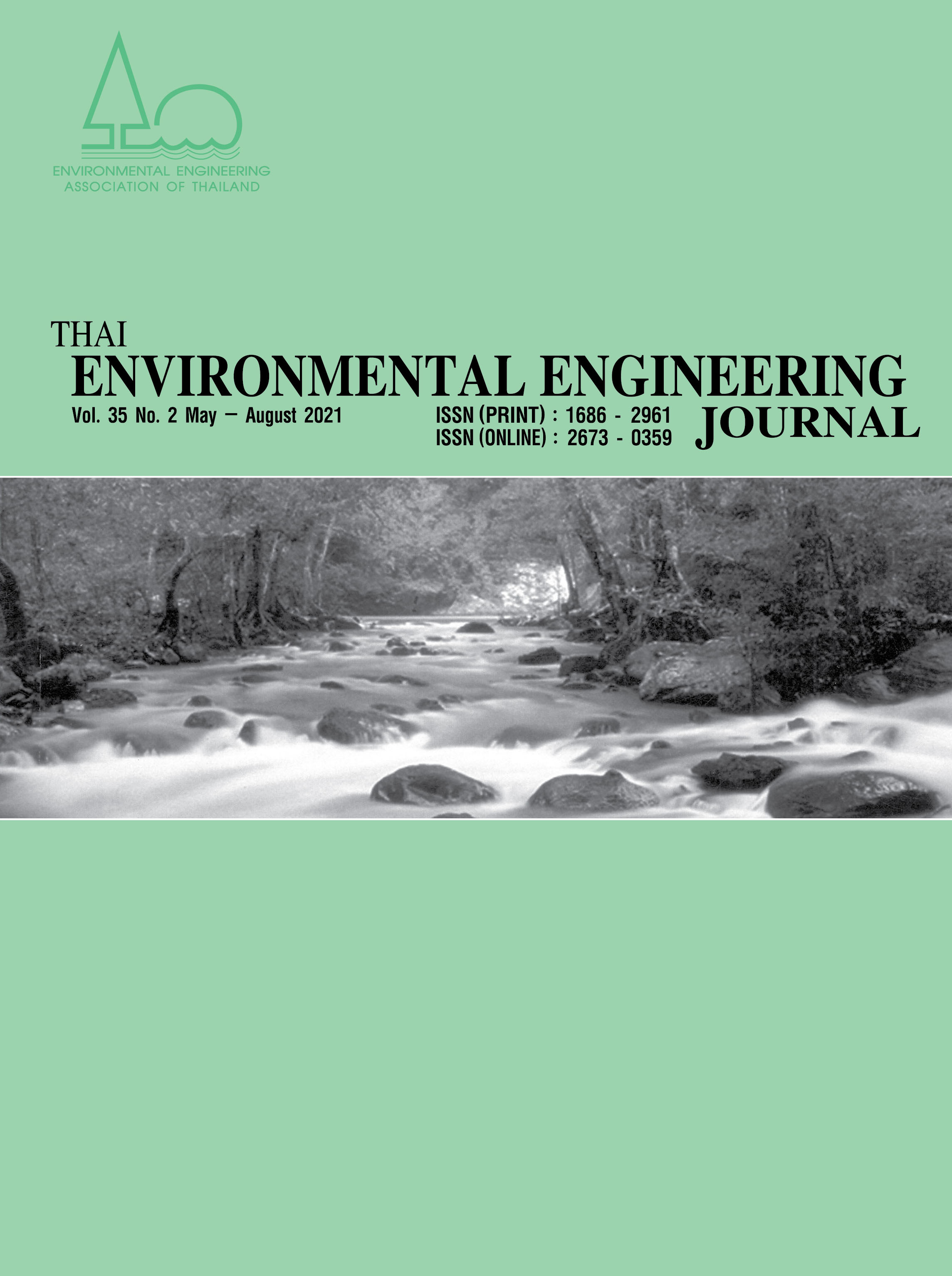Material Flow Analysis and Risk Assessment of Wastewater and Sludge Treatment in Bangkok, Thailand
Main Article Content
Abstract
This research evaluated the wastewater and sludge characteristics, and material flows in Nongkhaem Water Environment Control Plant. The constituent removal efficiencies of the wastewater treatment plant and human health risks (for children and adults) caused by sludge utilization were determined. The results from the Material Flow Analysis showed that the wastewater treatment process can remove nutrients efficiently. The removal rate of TOC, T-N, and T-P were 72%, 62%, 72% respectively. In case of heavy metal, the removal rate of heavy metals was between 62-87%. This means that it can reduce human health risks from heavy metals in treated water. Heavy metals content in sewage sludge can be ranked according to mean concentrations in the following order: Zn > Cu > Cr > Ni > Pb > As > Mo > Se > Hg > Cd. Cu, Zn and Cr were the top three highest heavy metals that caused non-carcinogen health risks for both children and adults. Heavy metals in dry-based sewage sludge would be toxic for children’s health (non-carcinogen health risks) but not for adults. The carcinogenic risks from sludge utilization were under the safe limit for both children and adults.
Article Details
References
Japan International Cooperation Agency, 2011. Preparatory survey for Bangkok wastewater treatment project in Thailand. [Accessed February 18 2020]. Available from: http://open_jicareport.jica.go.jp/pdf/12034542.pdf.
Adam, C., Peplinski, B., Michaelis, M., Kley, G. and Simon, F.G. 2009. Thermochemical treatment of sewage sludge ashes for phosphorus recovery. Waste Management. 29(3): 1122-1128.
Wierzbowska, J., Sienkiewicz, S., Krzebietke S. and Sternik P. 2016. Sewage sludge as a source of nitrogen and phosphorus for Virginia fanpetals. Bulgarian Journal of Agricultural Science. 22(5): 722-727.
Liu, B., Wei, Q., Zhang, B. and Bi, J. 2013. Life cycle GHG emissions of sewage sludge treatment and disposal options in Tai Lake Watershed, China. Science of the Total Environment. 447: 361-369.
Marani, D., Braguglia, C. M., Mininni, G. and Maccioni, F. 2003. Behaviour of Cd, Cr, Mn, Ni, Pb, and Zn in sewage sludge incineration by fluidised bed furnace. Waste Management. 23(2): 117-124.
Harrison, E. Z., Oakes, S. R., Hysell, M., and Hay, A. 2006. Organic chemicals in sewage sludges. The Science of the Total Environment. 367(2-3): 481-497.
Duan, B., Zhang, W., Zheng, H., Wu, C., Zhang, Q. and Bu, Y. 2017. Comparison of health risk assessments of heavy metals and As in sewage sludge from wastewater treatment plants (WWTPs) for adults and children in the urban district of Taiyuan, China. International. Journal of Environmental Research and Public Health. 14(10): 1194.
Dai, J.Y., Chen, L., Zhao, J. F. and Ma, N. 2006. Characteristics of sewage sludge and distribution of heavy metal in plants with amendment of sewage sludge. Journal of Environmental Sciences. 18(6): 1094-1100.
Ljung, K., Oomen, A., Duits, M., Selinus, O. and Berglund, M. 2007. Bioaccessibility of metals in urban playground soils. Journal of Environmental Science and Health Part A. 42(9): 1241-1250.
Acosta, J.A., Cano, A.F., Arocena, J.M., Debela, F. and Martínez-Martínez, S. 2009. Distribution of metals in soil particle size fractions and its implication to risk assessment of playgrounds in Murcia City (Spain). Geoderma. 149(1-2): 101-109.
Agoro, M.A., Adeniji, A.O., Adefisoye, M.A. and Okoh, O.O. 2020. Heavy metals in wastewater and sewage sludge from selected municipal treatment plants in eastern cape province, south africa. Water. 12: 2746.
USEPA. 1994. A Plain English Guide to the EPA Part 503 Biosolids Rule. U.S. Environmental Protection Agency Office of Wastewater Management, Washington, DC, USA.
Japan Sewage Works Association, 2012. Wastewater examination method, 2012 edition. Japan Sewage Works Association, Tokyo, Japan. [in Japanese]
Ministry of the Environment, Japan. 2012. Sediment survey method. [Accessed March, 21 2021]. Available from: https://www.env.go.jp/water/teishitsu-chousa/00_full.pdf (In Japanese)
Cencic, O. and Rechberger, H. 2008. Material Flow Analysis with Software STAN. Journal of Environmental Engineering and Management. 18(1): 3-7.
Cencic, O. 2016. Nonlinear data reconciliation in material flow analysis with software STAN. Sustainable Environment Research. 26(6): 291-298.
USEPA. 1989. Risk Assessment Guidance for Superfund. Human Health Evaluation Manual, (Part A). Office of Emergency and Remedial Response, Washington, DC, SA.
Qing, X., Yutong, Z. and Shenggao, L. 2015. Assessment of heavy metal pollution and human health risk in urban soils of steel industrial city (Anshan), Liaoning, Northeast China. Ecotoxicology and Environmental Safety. 120: 377-385.
Chabukdhara, M. and Nema, A.K. 2013. Heavy metals assessment in urban soil around industrial clusters in Ghaziabad, India: Probabilistic health risk approach. Ecotoxicology and Environmental Safety. 87: 57-64.
USEPA. 2017. Integrated Risk Information System. [Accessed March, 21 2021]. Available from: https://www.epa.gov/iris.
Department of Drainage and Sewerage, Bangkok. 2021. Information service. [Accessed March, 21 2021]. Available from: https://wqmo.blogspot.com/p/blog-page_28.html (In Thai).
Chanpiwat, P., Sthiannopkao, S. and Kim, K.W. 2010. Metal content variation in wastewater and biosludge from Bangkok’s central wastewater treatment plants. Microchemical Journal. 95(2): 326-332.
Yang, J., Gao, D. and Chen, T.B. 2015. Comparison of heavy metal removal efficiencies in four activated sludge processes. Journal of Central South University. 22: 3788-3794.
Yoshida, H., Christensen, T.H., Guildal, T. and Scheutz, C. 2015. A comprehensive substance flow analysis of a municipal wastewater and sludge treatment plant. Chemosphere. 138: 874-882.
USEPA. (2009) Targeted National Sewage Sludge Survey Statistical Analysis Report. [Accessed March, 21 2021]. Available from: https://19january2017snapshot.epa.gov/sites/production/files/2015-04production/files/2015-04/documents/tnsss_stat_anal_report_revised_april_2009.pdf
Mattsson, A., Finnson, A. and I’ons, D. 2017. Heavy metal content of Swedish municipal wastewater sludge-status and goals. Water Science and Technology. 76(4): 869-876.
Ozaki, M. 2011. Study on efficient and effective utilization of sewage sludge. [Doctoral Dissertation, Kyoto University] (In Japanese).


